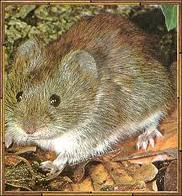Vole Description and Habitats
There are two types of Voles found in our service area, the meadow vole and the pine vole. They are 4” to 7 1/2 “ long weighing ½ to 2 ½ ounces. The meadow vole is larger than the pine vole. The meadow vole’s tail is longer than it’s hind foot. The pine vole’s tail is shorter that it’s hind foot.  In general, voles are brown or gray in color with dense fur. They are a compact rodent with a stocky body, short legs and a short tail. They look very much like a mouse. Voles eat green plants, roots, tubers, bark, mushrooms and occasionally snails, insects, carrion and each other’s young. They reside in fields and moist meadow bottomlands, but adapt well to suburban woodlots, gardens and ornamental plantings as well as orchards. Pine voles prefer deciduous forests, brushy areas and orchards with dense vegetation. Voles are polygamous and will breed all year round weather permitting. Gestation takes about 20 to 23 days with the average litter being 4 pups.
In general, voles are brown or gray in color with dense fur. They are a compact rodent with a stocky body, short legs and a short tail. They look very much like a mouse. Voles eat green plants, roots, tubers, bark, mushrooms and occasionally snails, insects, carrion and each other’s young. They reside in fields and moist meadow bottomlands, but adapt well to suburban woodlots, gardens and ornamental plantings as well as orchards. Pine voles prefer deciduous forests, brushy areas and orchards with dense vegetation. Voles are polygamous and will breed all year round weather permitting. Gestation takes about 20 to 23 days with the average litter being 4 pups.
Vole Animal Damage and Health Hazards
Voles primarily live in tunnels and runways under the lawn surface and hence are rarely scene. They create numerous surface or subsurface burrows and tunnels in a relatively small area, which contain many adults and young. Accumulated vole damage is apparent when vole populations are high. Vole damage typically consists of girdling and gnawing of trees, vegetable gardens destroyed by eating of highly nutritious roots, damage to lawns by extensive tunnel and runway systems along with tearing up mulch in flowerbeds. Voles are occasional carriers of tularemia, bubonic plague and are hosts to numerous internal and external parasites.
Vole Removal Services
Wildlife Busters utilizes an Integrated Wildlife Management Plan to successfully control vole populations. Our programs are a combination of habitat modification, exclusion services, trapping and deterrents/repellents. Habitat modification may include, soil cultivation, close mowing of lawn, clearing vegetation and reducing layers of mulch to 1 to 3 inches in flowerbeds. Exclusion techniques would include trench prevention and gravel barriers. If you are experiencing a nuisance wildlife issue with voles give Wildlife Busters a call and we will personally design an effective long-term solution to your vole problem.

 Receive FREE wildlife Tips!
Receive FREE wildlife Tips!
